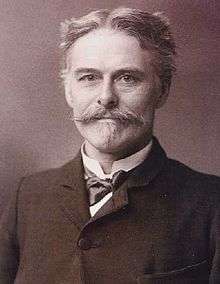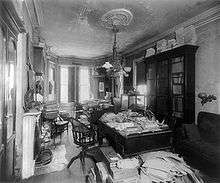Edward Drinker Cope House

|
Edward D. Cope House | |
.jpg) 2100-2102 Pine Street | |
   | |
| Location | 2102 Pine St., Philadelphia, Pennsylvania |
|---|---|
| Coordinates | 39°56′49.21″N 75°10′36.14″W / 39.9470028°N 75.1767056°WCoordinates: 39°56′49.21″N 75°10′36.14″W / 39.9470028°N 75.1767056°W |
| Built | 1880 |
| Architect | Unknown |
| Architectural style | Second Empire |
| NRHP Reference # | 75001660 |
| Significant dates | |
| Added to NRHP | May 15, 1975[1] |
| Designated NHL | May 15, 1975[2] |
The Edward Drinker Cope House is a historic house at 2100-2102 Pine Street in Center City Philadelphia, Pennsylvania. Built in 1880, it was a longtime home of Edward Drinker Cope (1840-1897), a prolific geologist and paleontologist and noted herpetologist who was one of the leading natural scientists of the 19th century United States. It was declared a National Historic Landmark in 1975.[2][3][4]
Description and history
The Edward Drinker Cope House consists of two side-by-side rowhouses at the southwest corner of 21st and Pine Streets, southwest of Rittenhouse Square in Philaldelphia's Center City. It is 3-1/2 stories in height, the top floor enlarged by a mansard roof. It is built out of rectangular cut green stone laid in random courses. The side of the building, facing 21st Street, is brick. The main facade has polygonal bays on the outside and a pair of entrances in round-arch openings in the center bays. The building is not architecturally distinguished.[3]
The two rowhouses were purchased by Edward Drinker Cope not long after their construction in 1880. He at first lived at 2100, and used 2102 as space for storage and a work room. Financial reverses due to a poor investment in 1886 forced him to rent 2100 out, and he occupied 2102 until his death in 1897. Cope was a prolific and talented scientist, Cope distinguished himself in particular in the field of paleontology, where he was one of the leading figures in the competitive Bone Wars that characterized the scientific investigations of the American West in the 1870s. He is ranked with Othniel Marsh and Joseph Leidy as one of the nation's leading 19th-century paleontologists.[3]

See also
- List of National Historic Landmarks in Philadelphia
- National Register of Historic Places listings in Center City, Philadelphia
References
- ↑ National Park Service (2007-01-23). "National Register Information System". National Register of Historic Places. National Park Service.
- 1 2 "Edward D. Cope House". National Historic Landmark summary listing. National Park Service. Retrieved 2008-02-16.
- 1 2 3 James Sheire (March 1975). "National Register of Historic Places Inventory-Nomination: Edward Drinker Cope Home" (pdf). National Park Service. and Accompanying one photo, exterior, from 1975 (32 KB)
- ↑ Williams, David B. (August 25, 2010). "Edward Drinker Cope: His Home Inside and Out". www.geologywriter.com. Retrieved July 13, 2016.
- ↑ Fowler, 196.
External links
- Historic American Buildings Survey (HABS) No. PA-1500, "Edward Drinker Cope Houses"

